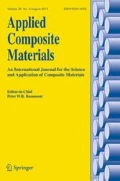Abstract
Tensile properties and failure mechanism of 3D woven hollow integrated sandwich composites are investigated experimentally, theoretically and numerically in this paper. Firstly, the tensile properties are obtained by quasi-static tensile tests on the specimens in two principal directions of the sandwich panels, called warp and weft. The experimental results shows that the tensile performances of the warp are better than that of the weft. By observing the broken specimens, it is found that the touch parts between yarns are the main failure regions under tension. Then, a theoretical method is developed to predict the tensile properties. By comparing with the experimental data, the accuracy of the theoretical method is verified. Simultaneously, a finite element model is established to predict the tensile behavior of the composites. The numerical results agree well with the experimental data. Moreover, the simulated progressive damages show that the contact regions in the warp and weft tension are both the initial failure areas.











Similar content being viewed by others
References
Ko F K, Du G W. Processing of textile preforms. Advanced composites manufacturing. 157–205 (1997)
Judawisastra, H., Ivens, J., Verpoest, I.: The fatigue behaviour and damage development of 3D woven sandwich composites. Compos. Struct. 43(1), 35–45 (1998)
Vaidya, U.K., Hosur, M.V., Earl, D., et al.: Impact response of integrated hollow core sandwich composite panels. Compos. A: Appl. Sci. Manuf. 31(8), 761–772 (2000)
Vuure V, Willem A, Ivens J, et al. Sandwich panels produced from sandwich-fabric preforms. International Symposium on Advanced Materials for Lightweight Structures. ESTEC, Estec Conference Bureau, Noordwijk, The Netherlands. 609–612 (1994)
Hosur, M.V., Abdullah, M., Jeelani, S.: Manufacturing and low-velocity impact characterization of hollow integrated core sandwich composites with hybrid face sheets. Compos. Struct. 65(1), 103–115 (2004)
Hosur, M.V., Abdullah, M., Jeelani, S.: Manufacturing and low-velocity impact characterization of foam filled 3-D integrated core sandwich composites with hybrid face sheets. Compos. Struct. 69(2), 167–181 (2005)
Hosur, M.V., Abdullah, M., Jeelani, S.: Dynamic compression behavior of integrated core sandwich composites. Mater. Sci. Eng. A. 445, 54–64 (2007)
Vuure, V., Willem, A., Pflug, J., et al.: Modelling the core properties of composite panels based on woven sandwich-fabric preforms. Compos. Sci. Technol. 60(8), 1263–1276 (2000)
Corigliano, A., Rizzi, E., Papa, E.: Experimental characterization and numerical simulations of a syntactic-foam/glass-fibre composite sandwich. Compos. Sci. Technol. 60(11), 2169–2180 (2000)
Sadighi, M., Hosseini, S.A.: Finite element simulation and experimental study on mechanical behavior of 3D woven glass fiber composite sandwich panels. Compos. Part B. 55, 158–166 (2013)
Cao, H.J., Wei, Q.F., Qian, K., et al.: Finite element analysis of the compressive properties of 3-D hollow integrated sandwich composites. Fibers and Polymers. 13(3), 358–362 (2012)
Zhou G, Liu C, Li W, et al.: Shear behavior of 3D woven hollow integrated sandwich composites: Experimental, theoretical and numerical study. Appl. Compos. Mater. 1–15 (2016)
Lomov, S.V., Gusakov, A.V., Huysmans, G., et al.: Textile geometry preprocessor for meso-mechanical models of woven composites. Compos. Sci. Technol. 60(11), 2083–2095 (2000)
Hearle J W S, Grosberg P, Backer S. Structural mechanics of fibers, yarns, and fabrics. 339–371 (1969)
Sun, J., Zhou, G., Zhou, C.: Microstructure and mechanical properties of 3D surface-core 4-directional braided composites. J. Mater. Sci. 50(22), 7398–7412 (2015)
Hashin, Z.: Failure criteria for unidirectional fiber composites. J. Appl. Mech. 47(2), 329–334 (1980)
Acknowledgements
This work was supported by the Fundamental Research Funds for the Central Universities, A Project Funded by the Priority Academic Program Development of Jiangsu Higher Education Institutions, and the Fundation of Graduate Innovation Center in NUAA (Grant No. kfjj20160111).
Author information
Authors and Affiliations
Corresponding author
Rights and permissions
About this article
Cite this article
Liu, C., Cai, D., Zhou, G. et al. Tensile Properties and Failure Mechanism of 3D Woven Hollow Integrated Sandwich Composites. Appl Compos Mater 24, 1151–1163 (2017). https://doi.org/10.1007/s10443-016-9581-5
Received:
Accepted:
Published:
Issue Date:
DOI: https://doi.org/10.1007/s10443-016-9581-5




